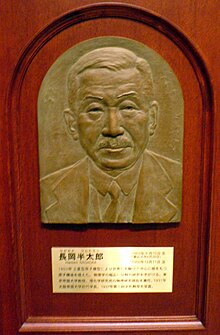Hantaro Nagaoka
Hantaro Nagaoka | |
|---|---|
 | |
| Born | August 19, 1865 |
| Died | December 11, 1950 (aged 85) |
| Nationality | Japanese |
| Relatives | Nagaoka Nobuko (granddaughter) |
| Scientific career | |
| Fields | Physics |
| Notable students | Kotaro Honda, Hideki Yukawa |

Hantaro Nagaoka (長岡 半太郎, Nagaoka Hantarō, August 19, 1865 – December 11, 1950) was a Japanese physicist and a pioneer of Japanese physics during the Meiji period.
Life
[edit]Nagaoka was born in Nagasaki, Japan on August 19, 1865 and educated at the University of Tokyo. After graduating with a degree in physics in 1887, Nagaoka worked with a visiting Scottish physicist, Cargill Gilston Knott, on early problems in magnetism, namely magnetostriction in liquid nickel. In 1893, Nagaoka traveled to Europe, where he continued his education at the universities of Berlin, Munich, and Vienna, including courses on Saturn's rings and a course with Ludwig Boltzmann on his Kinetic Theory of Gases, two influences which would be reflected in Nagaoka's later work. Nagaoka also attended, in 1900, the First International Congress of Physicists in Paris, where he heard Marie Curie lecture on radioactivity, an event that aroused Nagaoka's interest in atomic physics. Nagaoka returned to Japan in 1901 and served as professor of physics at Tokyo University until 1925. After his retirement from Tokyo University, Nagaoka was appointed a head scientist at RIKEN, and also served as the first president of Osaka University, from 1931 to 1934.
His granddaughter was pianist Nagaoka Nobuko.[1]
Saturnian model of the atom
[edit]By 1900 physicists had begun to consider new models for the structure of the atom. The recent discovery by J. J. Thomson of the negatively charged electron implied that a neutral atom must also contain an opposite positive charge. In 1904, Thomson suggested that the atom was a sphere of uniform positive electrification, with electrons scattered through it like plums in a pudding, giving rise to the term plum pudding model.
Nagaoka rejected Thomson's model on the grounds that opposite charges are impenetrable. In 1904, Nagaoka proposed an alternative planetary model of the atom in which a positively charged center is surrounded by a number of revolving electrons, in the manner of Saturn and its rings.[2]
Nagaoka's model made two predictions:
- a very massive atomic center (in analogy to a very massive planet)
- electrons revolving around the nucleus, bound by electrostatic forces (in analogy to the rings revolving around Saturn, bound by gravitational forces).
Both predictions were successfully confirmed by Ernest Rutherford, who mentions Nagaoka's model in his 1911 paper in which the atomic nucleus is proposed.[3] However, other details of the model were incorrect. In particular, electrically charged rings would be unstable due to repulsive disruption. Nagaoka himself abandoned his proposed model in 1908.
Rutherford and Niels Bohr would present the more viable Bohr model in 1913.
Other works
[edit]Nagaoka later did research in spectroscopy and other fields. In 1909, he published a paper on the inductance of solenoids.[4] In 1924, he achieved the first successful synthesis of gold, produced from mercury by neutron bombardment.[5] In 1929, Nagaoka became the first person to describe meteor burst communications.[6]
Nagoka also did early research on earthquakes, from the 1900s to the 1920s, building upon works published Europe; "One used the principle of elasticity studies against the background of the current that succeeded in France in the first half of the 19th century. The other defined potential functions and explained phenomena from continuous equations of the nature of waves against the background of new currents that emerged in Britain or Germany from the mid-19th century onwards."[7]
Awards and recognition
[edit]- For his lifetime of scientific work, Nagaoka was granted the Order of Culture by the Japanese government in 1937.
- The Nagaoka crater on the Moon is named after him.
References
[edit]- ^ Yamamoto, Takashi (2019). Leo Sirota: The Pianist Who Loved Japan. Translated by Bantock, Gavin; Inukai, Takao. Kashiwa: First Servant Books. p. 182. ISBN 978-4-9910037-1-4.
- ^ B. Bryson (2003). A Short History of Nearly Everything. Broadway Books. ISBN 0-7679-0817-1.
- ^ Rutherford either knew the article or looked it up, for he cited it on the last page of his classic paper, "The Scattering of a and b Particles by Matter and the Structure of the Atom," Phil. Mag., 21 (1911), 669.
- ^ Nagaoka, Hantaro (1909-05-06). "The Inductance Coefficients of Solenoids" (PDF). Journal of the College of Science. 27 (6). Tokyo, Japan: Imperial University: 18.
- ^ Miethe, A. (1924). "Der Zerfall des Quecksilberatoms". Die Naturwissenschaften. 12 (29): 597–598. Bibcode:1924NW.....12..597M. doi:10.1007/BF01505547. S2CID 35613814.
- ^ Hantaro Nagaoka (1929). "Possibility of the radio transmission being disturbed by meteoric showers". Proceedings of the Imperial Academy. 5 (6): 233–236. doi:10.2183/pjab1912.5.233. Cited in Wilhelm Nupen (1961). Bibliography on meteoric radio wave propagation. Washington: U.S. National Bureau of Standards. pp. 76. Retrieved 17 August 2014.
- ^ HISHIKI, Fuuka (December 23, 2022). "物理学者長岡半太郎の1900年代~1920年代における 地震研究の理論的手法の再検討". Bulletin of the National Museum of Nature and Science, Series E (in Japanese). 45: 1–11. doi:10.50826/bnmnsscieng.45.0.1. Retrieved December 29, 2023.
Sources
[edit]- C.C. Gillispie, ed. (2000). Concise Dictionary of Scientific Biography (2nd ed.). Charles Scribner's Sons. pp. 606–607. ISBN 0-684-80631-2.
- C.C. Gillispie, ed. (1974). Dictionary of Scientific Biography. Vol. IX: A.T. Macrobious – K.F. Naumann. Charles Scribner's Sons. p. 648. ASIN B000QA98QQ.
External links
[edit]- 1865 births
- 1950 deaths
- Japanese physicists
- People from Nagasaki Prefecture
- Recipients of the Order of Culture
- Academic staff of Osaka University
- Academic staff of the University of Tokyo
- University of Tokyo alumni
- Japanese theoretical physicists
- Honorary Members of the USSR Academy of Sciences
- Riken personnel
- Fellows of the American Physical Society
- Members of the Japan Academy
